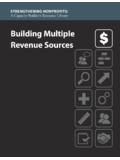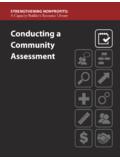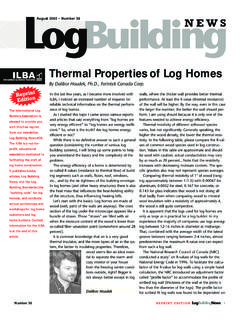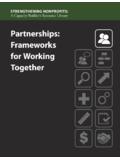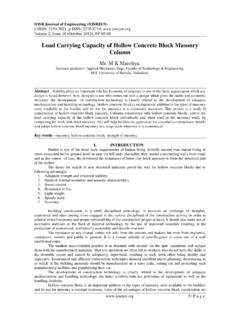Transcription of Measuring Outcomes - Strengthening Nonprofits:
1 Measuring OutcomesSTRENGTHENING NONPROFITS: A capacity Builder s Resource LibraryTABLE OF CONTENTSINTRODUCTION ..4 OVERVIEW ..5 Why Measure Outcomes ? ..5 What is outcome Measurement? ..5 Some Words of Caution: Limitations of Measuring Outcomes ..7 Effective outcome Measurement Practices ..8An outcome Framework ..9 GETTING STARTED ..91. Where Should We Focus? ..92. What Do We Want to Accomplish with Our outcome Measurement Efforts? ..104. How Can We Make This a Participatory Process? ..115. Is the Timing Right? ..126. What Resources Will We Need? ..12 PHASE 1: IDENTIFY Outcomes AND DEVELOP PERFORMANCE INDICATORS ..13 About Outcomes and outcome Statements.
2 13 Using outcome Chains ..14 outcome Chain Example ..15 Logic Models ..16 Developing Performance Indicators ..18 PHASE 2: CREATE AND IMPLEMENT A DATA COLLECTION PLAN ..21 Data Collection Methods ..21 Validity and Reliability ..25 Instrument Development and Pre-Testing ..26 Deciding When and How to Collect Data ..26 PHASE 3: ANALYZE THE DATA ..32 Tools for Analysis ..32 Sample Analysis and Data Displays ..33 PHASE 4: COMMUNICATE THE RESULTS ..37 What to Communicate ..37 How to Communicate ..38 Target Multiple Audiences ..38 PHASE 5: REFLECT, LEARN, DO IT AGAIN ..39 APPENDICES ..41 APPENDIX A: Online Resources: Survey and Questionnaire Development ..41 APPENDIX B: Glossary.
3 42 APPENDIX C: Sample Program Logic Model ..44 APPENDIX D: Outcomes and Indicators Worksheet ..45 APPENDIX E: Data Collection Plan Worksheet, Part 1 and 2 ..46 APPENDIX F: Getting the Best Results from Surveys and Interviews ..48 APPENDIX G : Technical Assistance Survey Template ..51 APPENDIX H: References ..544 INTRODUCTIONThe Compassion Capital Fund (CCF), administered by the Department of Health and Human Services, provided capacity building grants to expand and strengthen the role of nonprofit organizations in their ability to provide social services to low-income individuals. Between 2002 and 2009, CCF awarded 1,277 grants, and the CCF National Resource Center provided training and technical assistance to all CCF grantees.
4 Strengthening Nonprofits: A capacity Builder s Resource Library is born out of the expansive set of resources created by the National Resource Center during that time period, to be shared and to continue the legacy of CCF s capacity building work. Strengthening Nonprofits: A capacity Builder s Resource Library contains guidebooks and e-learnings on the following topics:1. Conducting a Community Assessment2. Delivering Training and Technical Assistance3. Designing and Managing a Subaward Program4. Going Virtual5. Identifying and Promoting Effective Practices6. Leading a Nonprofit Organization: Tips and Tools for Executive Directors and Team Leaders7. Managing Crisis: Risk Management and Crisis Response Planning8.
5 Managing Public Grants9. Measuring Outcomes10. Partnerships: Frameworks for Working Together11. Sustainability12. Working with ConsultantsWho is the audience for Strengthening Nonprofits: A capacity Builder s Resource Library?Anyone who is interested in expanding the capacity of nonprofit services in their community from front line service providers to executives in large intermediary organizations will benefit from the information contained in this resource library. The National Resource Center originally developed many of these resources for intermediary organizations, organizations that were granted funds by CCF to build the capacity of the faith-based and community-based organizations (FBCOs) they served.
6 As such, the majority of the resources in Strengthening Nonprofits: A capacity Builder s Resource Library support intermediary organizations in their capacity building efforts. However, funders of capacity building programs (Federal program offices and foundations) and the nonprofit community (including FBCOs) at large will also find these resources helpful. In addition, individuals working to build capacity within a program or an organization will be able to use these resources to support their efforts to implement change and make Measuring Outcomes guidebook will be helpful to any organization interested in learning more about implementing or improving its procedures for Measuring developed the Measuring Outcomes guidebook?
7 The guidebook was originally developed by the National Resource Center with assistance from Judy Clegg and Dawn Smart. It was updated in 2010 for the Department of Health and Human Services by the National Resource Center. 5 OVERVIEW Although there are many uses for the information generated by outcome measurement, organizations often make the effort because they are required to do so. They are asked to be accountable for the use of their grant maker s funds. This includes foundations and grant making organizations such as the United Way, as well as local, state, and Federal government agencies. In 1993, Congress enacted the Government Performance Results Act (GPR A) to ensure that the Federal government focuses on the performance of programs.
8 Federal departments are now required to assess the effectiveness of their programs. Most programs require grantees to report on activities and Outcomes throughout and after their grant, as well as participate in research and evaluation efforts. Every organization hopes to deliver quality services. outcome measurement will help you understand whether yours does. With the information you collect, you can determine which activities to continue and build upon and which you may need to change in order to improve the effectiveness of your program. Why Measure Outcomes ? outcome measurement has become one of the most important activities that social service organizations undertake.
9 There are several compelling reasons to measure Outcomes :1. Measuring the effectiveness of an intervention. How do you know if a program was effective? If a program was not effective, would you want to know so that it could be improved? It is unlikely that we build capacity simply for the sake of building capacity , and because of this, we need to know whether or not our programs are effective, just as the nonprofits we serve need to know if their services are achieving the desired Identifying effective practices. With the information you collect, you can determine which activities to continue and build upon. Some practices might be modified and replicated for other programs or initiatives based on your Identifying practices that need improvement.
10 Some activities may need to change in order to improve the effectiveness of your Proving your value to existing and potential funders. The climate for funding social services and capacity building has undergone some radical transformations in the last few decades. Funders are keenly aware of the need to document the success of programs. capacity building has lagged somewhat behind the social services field in having established evaluation standards. In 2003, the Alliance for Nonprofit Management reported that the capacity building field still lacked a framework for evaluation. However, this is changing, and it is important for capacity builders to stay ahead of the curve to be able to continue doing their Getting clarity and consensus around the purpose of your program.
